Monday Jan 27, 2025
Monday Jan 27, 2025
Saturday, 28 May 2016 00:36 - - {{hitsCtrl.values.hits}}
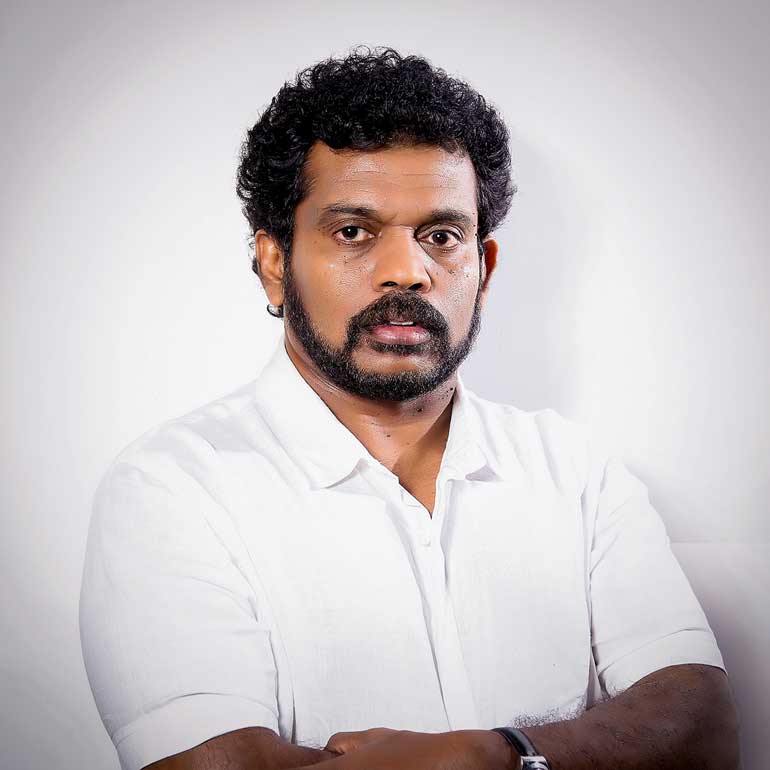 Asoka Handagama
Asoka Handagama
 Asoka Handagama’s latest film ‘Let Her Cry’ is currently being shown in theatres on a limited run from 13 May to 10 June. The director apparently preferred to utilise the gap in between already-scheduled releases and screen his film rather than wait for 16 more months in the queue to get a release. The 104-minute-long film’s title in Sinhala is ‘Ege Esa Aga,’ which means ‘The corner of her eye,’ but the filmmaker seems to have opted for ‘Let Her Cry’ as the official title in English.
Asoka Handagama’s latest film ‘Let Her Cry’ is currently being shown in theatres on a limited run from 13 May to 10 June. The director apparently preferred to utilise the gap in between already-scheduled releases and screen his film rather than wait for 16 more months in the queue to get a release. The 104-minute-long film’s title in Sinhala is ‘Ege Esa Aga,’ which means ‘The corner of her eye,’ but the filmmaker seems to have opted for ‘Let Her Cry’ as the official title in English.
Asoka Handagama has a track record and reputation for causing controversy through his cinematic creations. The ace filmmaker has the temerity and ability to wade into unchartered territory where few have dared to venture before and explore explosive issues in an unconventional manner. Each one of his earlier feature films – seven in all – are unparalleled cinematic achievements resulting in passionate debate and heated discussion. ‘Ege Esa Aga’ seems to be no exception.
I am aware that a hectic exchange of views is currently on in Sinhala about the film and its merits. Unfortunately my lack of fluency in the language does not let me benefit from this exchange. I shall however write about my impressions of the film and observations about film related matters in this week’s ‘Spotlight’ which is appearing after several weeks in the ‘Weekend FT’.
Handagama’s movie-making history
Let me begin with a brief comment outlining Asoka Handagama’s movie-making history. Asoka has made seven feature films so far. They are ‘Chanda Kinnari’ (1993), ‘Sanda Dadayama’ (1996), ‘Me Mage Sandai’ (2000), ‘Thani Thatuwen Piyambanna’ (2002), ‘Aksharaya’ (2005), ‘Vidhu’ (2010) and ‘Ini Avan’ (2012). Six of them are Sinhala films and one is a film in Tamil (‘Ini Avan’).
His latest and eighth film ‘Ege Esa Aga’ (‘Let Her Cry’) was cleared by the Censor Board for release in March 2016. The shooting was over before October last year and post-production complete by November. The film has been shot mainly in a few houses and roads in Colombo and its suburbs. A Buddhist temple in Dehiwala and beaches in Panadura have also been used as locations. Apart from directing, Asoka Handagama has written the film script and also the words of the theme song ‘Aharenna’ (‘Wake Up’).
Initially when Handagama embarked on this film project, he adopted a novel method to acquire the necessary finances. He introduced the concept of “crowd funding” by which one raises funds through financial contributions from a large group of generally unknown people instead of getting finance from a known group of investors.
Though Handagama’s innovative crowd funding technique was welcomed by many, the actual response to it was lukewarm. The funds garnered through crowd funding were woefully inadequate to meet the envisaged budget. Hence the filmmaker had to find other avenues to produce the film. Jagath Wijenayake stepped in and produced the film for Silumina films. The funds raised via crowd funding were used for post-production expenses.
Cinematographic delight
The opening sequence of the film is a cinematographic delight. The windscreen of a moving vehicle is shown on a dark night. It is raining. A pair of wipers move side to side wiping the raindrops on the windscreen. Headlights of passing vehicles are reflected on the screen. We hear voices, one of which is a male voice. The conversation is about an incident where a woman had reportedly pulled out a lamp post to attack another woman. There is amazement at the strength displayed and also about the motivating reasons for doing so. There is some laughter too. And then a woman starts crying. When asked the reason for crying, the reply is, why cannot someone cry if someone could laugh? Then the male voice wraps up the conversation saying – LET HER CRY! The three words ‘Let Her Cry’ form the English title of Handagama’s new film.
There are four major and several minor characters in the film. The main roles are an ageing professor, his once-beautiful wife, their alienated daughter addicted to TV and an attractive female undergraduate. There is also a son who is not shown in the film but we gather from family conversations that he is in the USA.
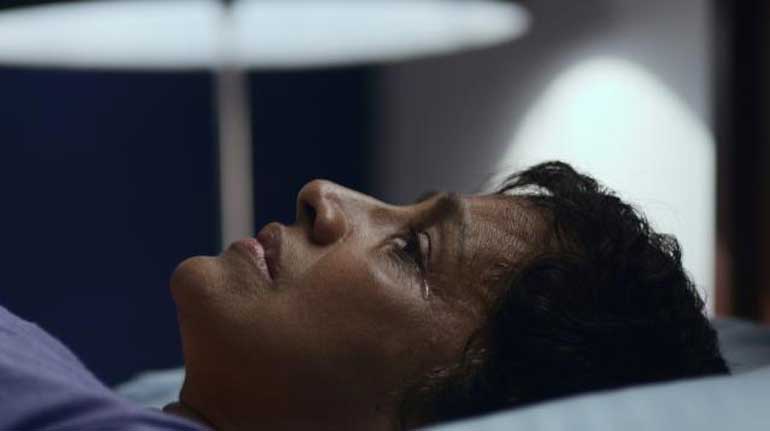
The relationship
The underlying thread of the story is the relationship between the professor on the verge of retirement and his nubile undergrad student.
The girl is someone who was born out of wedlock and by her own admission does not know who her father was. She is reportedly from a rural background but appears to be without inhibitions. She is aware of her beauty and the effect it has on men. She even boasts that the women in her village keep their men and even dogs on a leash to keep them away from her. They also do not allow her to sit in front during “Bana” preaching at the temple because of the fear that her alluring presence could confuse the Buddhist monk preacher.
The girl undergrad is obsessed by the Professor. It is more than a youthful crush for an older man or the longing of a girl who does not know her father for a substitute father figure. She appears to be obsessed by the professor totally and tells him candidly that she comes to the varsity only to see him. She is brazen enough to tell the professor’s wife that she wants to have a child by the professor.
The professor is a sophisticated person who seems more comfortable with a Westernised rather than Eastern way of life. He converses most of the time in English instead of Sinhala and also uses the fork and spoon while eating. His response to the nubile undergrad’s overtures are somewhat ambiguous and uncertain. He seems to be torn by suppressed desire for the girl on the one hand while being inhibited by family values and societal norms on the other.
His relationship towards his wife and daughter are quite strained and somewhat routinely mechanical. The only time he displays some passion for life is when he is with the girl undergrad. However he is unable or unwilling to interact with her more openly or more fully despite the girl’s entreaties. Any doubts we may entertain about the ageing professor being possibly impotent is removed by the sight of an erection in his sleep.
The family
The wife is a woman who was once very lovely and beautiful. A glimpse of an old photograph shows how pretty and attractive she was in the past. Age is now withering her beauty and the ordinary routine of everyday existence makes her life stale. Her sole solace seems to be worshipping a Buddha statue at home and regularly going to the Buddhist temple.
Their bespectacled daughter who was born 10 years after her elder brother is seemingly addicted to TV. She curls up on a chair in front of the TV and frequently switches channels on the remote with a look of utter disdain and boredom on her face. Her father brings her a delicacy to eat every day and she accepts it without evincing any emotion.
The dreary monotony of their lives and the sense of isolation felt by each is amply illustrated by the director through a repetition of sequences. The father comes home to find the daughter on the chair watching TV. He drops on her lap or hands over a delicacy which he regularly brings home. He then goes up the steps looking at his wife in the shrine room immersed in what seems to be meditation before a Buddha statue. He goes up to his room and removes his shirt and footwear. The wife walks up in a measured gait and disposes of the clothes and footwear. He then goes to the bathroom clad in a towel.
How firmly this routine has been entrenched in their lives is shown in a scene where the wife enters the bathroom after her husband while he is inside. He is shocked and remonstrates with her, pointing out that she has never done so in the past.
Unexpected move
Fearing that public knowledge of her husband’s relationship with the girl could affect his status and prestige, the wife resorts to an unexpected move. She invites the undergrad to move into their house and gives the absent son’s room for her to stay in. The entry of the girl undergrad into the routine, boring lives of the three family members is like a breath of fresh air. It is troublesome and worrying at one level but at another level the interaction with her does add some spicy zest to their insipid lives.
For the first time in the film we are shown scenes of laughter and pleasant conversation when meals are being eaten by the family at the table. The two younger girls also engage in jovial conversation when they go in the car in the mornings. There are also undercurrents of jealousy. The older woman is threatened by the youthful beauty of the girl while the daughter resents the attention being shown to the “guest” in different ways by her parents.
Matters come to a head when the mother takes the girl along with her to the temple instead of the daughter despite the latter’s specific request to that effect. This makes the daughter angry with the undergrad and leads to a scuffle in the car. When the angry father slaps the daughter, the enraged girl tries to commit suicide but is saved by the undergrad. Upset by this incident the girl moves out of the house even though the mother – grateful for having saved her daughter – wants the undergraduate to stay. After her departure the family feels an empty void in their lives. All three want her to come back but for different reasons.

Melodramatic scenes
As the movie nears its climax there are some melodramatic scenes. The mother goes to the temple on a Poya Day. She refuses to let the daughter accompany her. The father returns home and finds the daughter in a sullen mood. He playfully teases her and in a conciliatory gesture to alleviate her hurt feelings, takes the daughter to the temple. In what appears to be a coincidence the undergrad clad in pure white attire too has come to offer flowers at the same “Pansala”. Even as we wonder about what may possibly happen at this unexpected confluence of the four main characters at the temple, a different set of events takes place.
Luxury vehicles arrive at the temple and a Very Important Person (VIP) with his wife and armed bodyguards clambers out. He looks like the archetypal Sri Lankan politician. They greet the monk in charge of the temple respectfully. The wife sees another woman at the temple and gets angry. She makes a beeline for her and accuses the woman of having an affair with her husband. There is an argument leading to a physical tussle between both women. In an act of frenzy the aggrieved spouse pulls out a lamp post and tries to attack her rival. There is a huge hullabaloo and some shots are fired.
In the ensuing pandemonium, the professor, along with his wife, daughter and the young girl, hurriedly run away from the Pansala and seek refuge in the car. It is also raining. The vehicle then starts moving. Within a few seconds we realise that we are now back to the opening sequence. The same sequence shown at the beginning of the film is shown as the end of the film also. The same sequences are seamlessly woven into the narrative without resorting to conventional flashback techniques.
The conversation in the dark is the same but now we have a better understanding of what the conversation was all about. The night is yet dark but there is greater clarity in our minds. We recognise a parallel between the plights of the professor’s wife and the VIP’s wife at the temple. The manner in which both women try to resolve their problem is different. After a while the wife begins to cry and we understand the reasons for it. Finally when the professor says ‘let her cry,’ we too are in agreement because we now have the wisdom of hindsight having seen the entire narrative unfold on screen. It is a powerful experience for the viewer.
This experience is further enhanced by the theme song that follows as the film ends. The words were written by Asoka Handagama. The melody was composed and sung by internationally-renowned musician and vocalist Chitral Somapala. Chity, as Chitral is popularly known, provides a remarkable rendition of the song that overwhelms you by sheer evocative power. Our senses awaken and rise up to reach new heights as Chitral’s voice thunders to a crescendo in ‘Aharenna’ (Wake Up).
Challenging and stimulating
Films made by Directors like Asoka Handagama frequently challenge the discerning viewers’ imagination and stimulate their intellect. ‘Let Her Cry’ is no exception. There is a strong element of fantasy in the film. What you see is not what you get. Some of the twists and turns in the film are actually scenes of fantasization by the key characters. Those scenes are “situations” created in the imagination of the individual characters. At times this is a form of giving expression to their suppressed desires, hidden fears or irrational suspicions.
How does the viewer differentiate? It is somewhat a challenging yet pleasantly stimulating task. To his credit, Asoka Handagama does provide clues to help us understand better. The background music plays an important role in aiding us to assess the levels of fantasization. The difficulty faced by the girl undergrad in closing or opening the door as opposed to the relative ease with which others do so is another clue. So is the sudden appearance and disappearance of the girl in the professor’s car. The most effective clue perhaps is the perfume bottle. The hole in the blanket scene as well as the lingering fragrance permeating the house and the Professor’s body are related to the contents of this bottle being reduced.
Creative and imaginative filmmakers like Handagama excel at making movies of the mind like these. Some however misunderstand such efforts and malign the director unfairly. I saw a TV interview of Handagama where the Director was told he was mentally ill or psychologically afflicted to make such a movie. When told he was a ‘manasika rogi’ in the interview, Asoka Handagama replied, “We all are ‘manasika rogeen’. But only few people can make a film on their own ‘rogaya’. I am one of those who could do a film on it. That is the difference.”
As stated earlier the film has four main characters – the voluptuous girl undergraduate, the elderly professor, his once-alluring wife and their alienated daughter. These four parts are played to perfection by the chosen actors who fitted their roles perfectly. The director is to be commended for finding appropriately suitable actors and eliciting praiseworthy performances from them.
Dhritiman Chatterjee
 The chief protagonist is the ageing professor. This character required a certain amount of panache. The professor speaks most of the time in ‘accented’ English. The few words he speaks in Sinhala are stilted. One is unsure as to whether the professor is a Sri Lankan or a non-Sri Lankan living in Lanka. What we are sure of however is that the thespian who acted as the professor is an Indian. He is none other than the Bengali actor Dhritiman Chatterjee who made his screen debut in ‘Pratidwandi’ directed by Indian maestro Satyajit Ray. Chatterjee has been acting in many films and also in English stage plays in Chennai since 1970. Apart from acting in Satyajit Ray films like ‘Agantuk’ and ‘Ganasatru,’ Dhritiman Chatterjee has acted in the films of famous Directors like Mrinal Sen, Aparna Sen, Mani Ratnam, Sanjay Leela Bhansali, Deepa Mehta and Jane Campion.
The chief protagonist is the ageing professor. This character required a certain amount of panache. The professor speaks most of the time in ‘accented’ English. The few words he speaks in Sinhala are stilted. One is unsure as to whether the professor is a Sri Lankan or a non-Sri Lankan living in Lanka. What we are sure of however is that the thespian who acted as the professor is an Indian. He is none other than the Bengali actor Dhritiman Chatterjee who made his screen debut in ‘Pratidwandi’ directed by Indian maestro Satyajit Ray. Chatterjee has been acting in many films and also in English stage plays in Chennai since 1970. Apart from acting in Satyajit Ray films like ‘Agantuk’ and ‘Ganasatru,’ Dhritiman Chatterjee has acted in the films of famous Directors like Mrinal Sen, Aparna Sen, Mani Ratnam, Sanjay Leela Bhansali, Deepa Mehta and Jane Campion.
Satyajit Ray once paid Dhritiman Chatterjee a great compliment. Ray said: “I do not know what definition of a star these filmmakers have been using, but mine goes something like this. A star is a person on the screen who continues to be expressive and interesting even after he or she has stopped doing anything. This definition does not exclude the rare and lucky breed that gets lakhs of rupees per film; and it includes everyone who keeps his calm before the camera, projects a personality and evokes empathy. This is a rare breed too but one has met it in our films. Dhritiman Chatterji of ‘Pratidwandi’ is such a star.”
I was able to realise the truth in Ray’s words about Chatterjee when I saw Dhritiman’s polished performance in ‘Let Her Cry’. “Brilliant” was the word that came to mind as I saw Dhritiman Chatterjee portray the ageing professor on screen.
Asoka Handagama is to be congratulated for selecting Chatterjee for the role. I asked Asoka as to why he did not pick a Sri Lankan actor for the part and this is what the Director said: “I wanted a fresh figure for the part. Someone whose appearance could make the audience believe that he was a professor. I needed somebody who could display sophistication. After Gamini Fonseka, I don’t think there has been an actor in our cinema to bring out that level of sophistication on screen. Peter D’Almeida was the closest I could think of among Sri Lankans for the part. But Peter is too young or at least he looks too young for this role. So I opted to search from the outside. The credit should go to Prasanna Vithanage for introducing him to me.”
(Incidentally Prasanna Vithanage too picked an Indian actress Anjali Patil for his ‘Oba Nathuwa, Oba Ekka’. She won India’s Silver Peacock Best Actress Award for her performance).
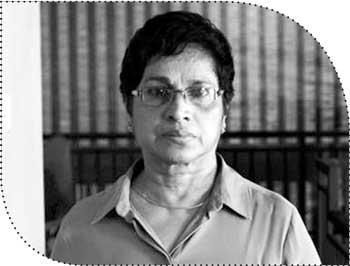 Swarna Mallawarachchi
Swarna Mallawarachchi
Sri Lanka’s own Swarna Mallawarachchi plays the role of the wife/mother in a restrained yet terrific performance. It was indeed good to see Swarna on screen again after many, many years. She has not been acting for about two decades. Swarna, described by some of her fans as the “golden star of Sinhala cinema,” is one of our most accomplished actresses. She has won ‘Best Actress’ awards for numerous films such as ‘Dadayama,’ ‘Hansa Vilak,’ ‘Maya,’ ‘Suddhilage Kathawak,’ ‘Sagara Jalayak,’ ‘Kadapathaka Chaya,’ ‘Anantha Rathriya,’ ‘Bawa Duka’ and ‘Channa Kinnari,’ which was her last Sinhala film to be screened.
Interestingly enough Swarna Mallawarachchi’s last film ‘Channa Kinnari’ was also the first Sinhala film made by Asoka Handagama. Though produced in 1993, the film was released in theatres only in 1997. Swarna, who faded away from films after Asoka Handagama’s ‘Channa Kinnari,’ has now made a re-appearance in the same Director’s ‘Ege Esa Aga’ or ‘Let Her Cry’. Swarna as usual gives off a superlative performance. The long absence does not seem to have affected her except for the fact that she is older and also looks older due to the requirements of the character she plays.
Seeing Swarna’s scintillating performance on the screen after many years gave rise to the question, “Why did we not see her all these years?” Asoka Handagama has indeed pulled off a casting coup by picking Swarna for the role. Besides it has enabled her re-entry into films.
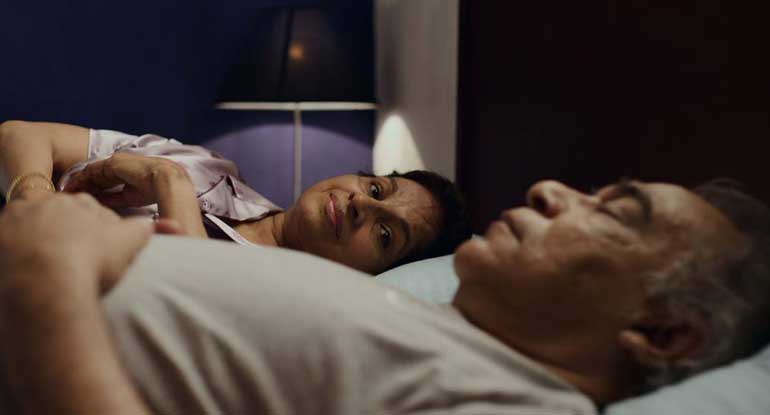
I asked the Director about his choice of Swarna Mallawarachchi and this is what he said: “I had no choice other than Swarna. She perfectly fitted this role. I wanted someone who had been very sexy in her young age to be this late-middle-aged lady but I did not want to show those younger days when she was a beauty through conventional flashbacks. To give an indication of her youthful beauty I placed a framed photo of her by her bedside in the film.”
Elaborating further, Asoka went on to say: “But for a Sri Lankan audience there is more than that. We have the memory – outside this film – of her younger days. She was very hot and sexy on screen those days. Those images are still available in our cinema domain. She now appears in a big screen role after 23 years. There are no images to show how she has been ageing in cinema. So this appearance of Swarna is very exclusive.”
 Rithika Kodithuwakku
Rithika Kodithuwakku
Another alluring performance was by Rithika Kodithuwakku who acts as the girl undergrad obsessed with the professor. She is youthful and attractive with a magnetic figure and is sexually appealing. She looks very seductive in the enticing scenes as well as appearing endearingly coy at times. The part she plays is that of a refreshingly direct and frank person without false pretences.
Rithika does very well in her role, often expressing herself through her eyes and looks. It is really hard to believe that Rithika Kodithuwakku is making her debut in this film. Rithika is a model and Asoka Handagama had picked her to play this role after seeing her images. The Director has indeed made a good find. Rithika, with her bewitching eyes, lissom body and above all her acting skills, does have a bright future in cinema.
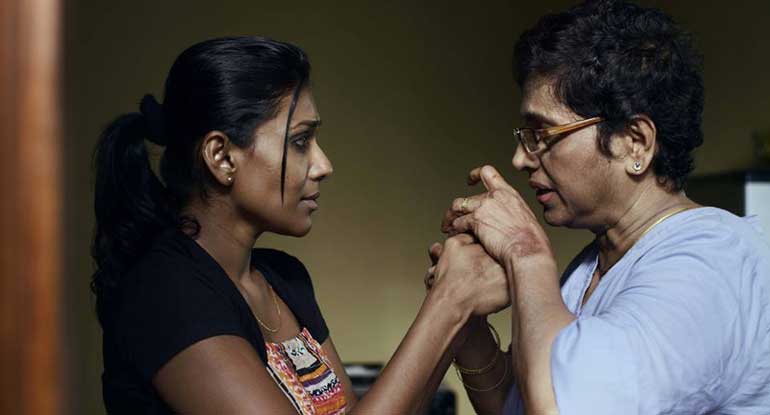
 Sandali Ash
Sandali Ash
Sandali Ash plays the young daughter’s role. She is none other than the Director’s own daughter herself. Apparently Asoka Handagama had searched far and wide for a suitable actress and found none. Finally he thought of casting his daughter. She, like the other three main actors, has played her part commendably well.
From the disinterested girl watching TV endlessly to the daughter shouting and fighting with her parents, Sandali acts sensitively and sensibly. However a Facebook entry by Sandali shows that the performance has extracted a heavy emotional toll on her. The girl had found it extremely difficult to shout abusively at Dhritiman whom she respected and at Swarna whom she loves as “Swarna Nandi” but this was what her role needed to do. So she has done it after whipping herself up into the right mood by snapping at everyone.
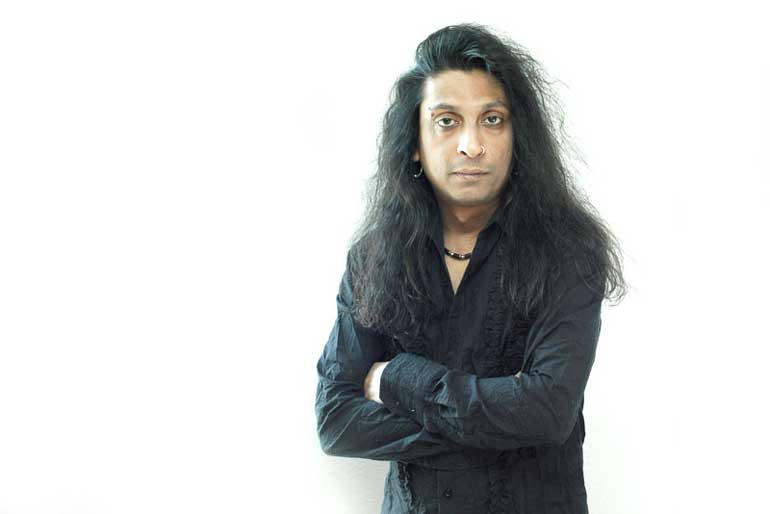
Other roles
Apart from Dhritiman, Swarna, Rithika and Sandali, there are some minor roles. They are played by actors such as Hashinika Karaliyadda, Thilakshani Rathnayake, Asoka Zoysa King Ratnam, Keerthi Ranjith Peiris and Amarapala Karasinghearachchi. Many of Asoka’s regular team have been involved in the making of the movie. Channa Deshapriya is the Cinematographer and Ravindra Guruge the Editor. Upul Chamila Bandara is in charge of sets and Aruna Priyantha Kaluarachchi of Sound. Costumes are by Purnima Muhandiram.
The music is by Chitral Somapala, who has also sung the theme song. Chitral ‘Chity’ Somapala’s music and rendition of the theme song ‘Aharenna’ (Wake Up) is an effective highlight of the film. Already the theme song sequence is a hit on the internet.
I asked Asoka Handagama as to why he chose Chitral and also about the theme song. The Director responded thus: “I wanted a different flavour in this scope as well. Music plays a very vital role in this movie because this film is all about fantasising. Chitral is not just a rock artiste. He is a very knowledgeable musician. I wanted to give him a chance. He did it well. He wanted a song made on the film theme. Our initial idea was to keep it outside the film. I did the lyrics and he composed a beautiful and very powerful song. His voice enhanced that power even more. When it is heard at the end with the titles, the audience will get deeply involved in it. As you come out from the theatre, you take along the feeling of the song also…”
Admirable restraint
One of the first things that struck me after seeing this immensely overpowering movie was the restraint shown by Asoka Handagama in directing the film. A film dealing with the subject of forbidden love between an elderly professor and his younger student provides much scope for hot and steamy scenes. Too much of explicit passion and intimate physical contact displayed in the shots could make the film go beyond limits into a ‘blue film’ realm.
To his credit Handagama has consciously refrained from that in the film. The two acts of physical intimacy are done under bed-sheets though a hole in one sheet is the aperture through which we witness some sex scenes from the Professor’s perspective. Another aspect is the long skirts worn by the undergrad whereby her curvaceous body is covered.
When I complimented Asoka for underplaying such scenes, he replied: “One could have made a pornographic movie along these lines. There are such films like that. Some people are trying to relate this film with those. But I didn’t want to do such an exercise. It is not my task.”
There have been films about an older man-younger girl relationship like ‘Lolita,’ ‘Nool Vely,’ ‘Azhaghan,’ ‘That Obscure Object of Desire,’ ‘Nishabdh’ and ‘Elegy,’ etc. Conversing with Asoka, I asked him whether Stanley Kubrick’s ‘Lolita’ based on the novel by Vladimir Nabokov starring James Mason and Sue Lyon may have had an impact on him in making ‘Let Her Cry’. Handagama replied: “I have watched that movie, but I don’t think so.”
He went on to say: “There are some other movies like ‘Obscure Object of Desire’ by Luis Buniel which have had more influence on the film.” Incidentally ‘That Obscure Object of Desire’ by Bunuel was about a romance between a wealthy middle-aged man and a beautiful young flamenco dancer. Fernando Rey plays the man but in the case of the girl, two actresses – Carole Bouquet and Angela Molina – play the same role.
Political dimension
Another inevitable or even indispensable aspect of Asoka Handagama’s cinema has been the political dimension. He has dealt with issues of a political nature in his own inimitable mode in the past. This has led to much controversy. One of his films, ‘Aksharaya,’ was banned.
Handagama has confronted political issues like oppression, the civil war, poverty, exploitation, tradition, the judiciary, power, etc. in his previous movies. Compared to those films, his latest ‘Let Her Cry’ appears to be “less political” in content and form. When I queried him about it, Asoka strongly disagreed, saying: “This is not less political. It is very political. The difference is you have to dig deep to identify the political discourse and bring it up to surface.”
‘Let Her Cry’ has already won laurels for Asoka Handagama internationally. The film has been screened at the Tallinn Black Nights Film Festival in Estonia, the Kolkata International film festival in India and the Jeonju International Film Festival in South Korea. International fame and glory is most welcome but I think filmmakers rooted in Sri Lanka like Asoka Handagama do not make films for a foreign audience. They make it specifically for the people of their own country. Durable happiness is only when their films reach a wide audience in their own country.
I truly hope and wish that Asoka Handagama’s ‘Eke Esa Aga’ is appreciated by a large number of discerning viewers in his own country – Sri Lanka!